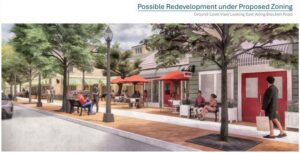EASTHAM — It hardly looks like the Eastham so many of us know. Locals chat on benches edged with flowers, while visitors dine under red umbrellas at the sidewalk’s edge. What was once a barren parking lot is a bustling town center featuring year-round businesses on ground floors and year-round housing up above.

That’s the vision, at least, that underlies the proposed new zoning code for the North Eastham Business District, which runs along Route 6 from Old Orchard Road to the Wellfleet town line.
On Jan. 21, the town’s Zoning Task Force led a workshop at the Eastham Public Library outlining the new code, which will come before town meeting voters on May 5. Members of the select board, planning board, and zoning board of appeals were in attendance as the task force outlined a plan that would change the look of the business district over decades.
To maintain the visual character of a Cape Cod village center, the new “form-based code” would include complex rules for the size and shape of buildings, said Community Development Director Paul Lagg, but would be less strict about the use of buildings. Building owners would not be forced to change their properties now, but future development would be shaped by the new rules.
“Nothing in the plan is a mandate,” said Mary Nee, chair of the Zoning Task Force. “We aren’t land developers. We just wanted to look very comprehensively at all the planning the town has done,” Nee said, adding that the task force had written zoning rules that conform to those plans.
Nee said that addressing the lack of year-round business opportunities was a major goal of the revision. The town’s 2021 market study had found that business opportunities in Eastham were limited by a “lack of quality retail establishments oriented toward year-round residents,” as well as a “high percentage of seasonal residents limiting the year-round customer base.”
According to the town’s housing production plan, which was updated last year, the median price of homes in Eastham more than doubled between 2010 and 2023 — from $381,000 to $775,000.
The housing production plan also found that more than 300 year-round rental housing units in Eastham had been lost since 2000. As a result of these changes, the town is “rapidly losing younger residents,” Nee said, with a 32-percent decline in residents between ages 18 and 34 since 2000.
Lagg said the town should focus on housing for the “missing middle” — residents who are looking for housing options between single-family homes and large apartment complexes. “We don’t need more single-family homes,” Lagg said, adding that the town does need more accessory dwelling units, duplexes, and “top of shop” units built above commercial spaces.
To accomplish these aims, the new zoning code would incentivize mixed-use buildings with the maximum height increased from 30 to 39 feet.
“The way these private properties redevelop is going to dictate where we as a town end up on housing in the future,” Lagg said. “We won’t get everything we need from a few scattered sites owned by the town.”
An Eight-Year Journey
The road to the new zoning codes began in 2017, when Eastham received a proposal from the Boston firm Lisciotti Development to build a Dollar General store on a vacant lot on Route 6.

Despite the backlash from residents, the store would have conformed to the town’s zoning rules for the area, Lagg told the Cape Cod Times in June 2017.
Eastham found other ways to fight back, though. Later that year voters designated a 280-acre corridor from Old Orchard Road to the Wellfleet town line as a “district of critical planning concern,” temporarily freezing development in the area so the town could rewrite its zoning regulations. The empty lot where the 9,100-square-foot Dollar General would have stood is now the location of Cedar Banks Landing, a condo complex built in 2020.
Since then, Eastham has adopted a number of town plans that are unsupported by its zoning, Nee said, including a strategic plan, a Village Center Master Plan, and the housing production plan. The Zoning Task Force was assigned in 2023 to examine the district of critical planning concern and produce a zoning code that would match those planning documents.
“In some cases, the vision was very ambiguous,” Nee said. “The current zoning calls for a ‘traditional New England village,’ but it doesn’t provide any detail on what that means.”
The new form-based code provides lots of detail, though it could be decades before many properties are redeveloped. Two large town-owned parcels might be among the first to be redeveloped under new rules, Nee said.
Eastham voters purchased the defunct T-Time driving range, which sits on an 11-acre parcel, in 2019 and the 3.5-acre Town Center Plaza in 2021. The redevelopment of those properties into housing and new commercial space hinges on the town’s ability to develop and finance a wastewater management plan, the Independent reported last year.
Nonetheless, the town’s future projects at those sites will “establish the expression of the zoning,” Nee said. “The benefit of the town being the first to market is that it can demonstrate what the architecture and land use can be.”
“These are significant changes when we talk about density of housing and height of housing” in the central business district, said Martin Ridge, who is a member of the zoning board of appeals and the Zoning Task Force. “Everyone in this room needs to dig down into the materials and fully understand them” so they can advocate for the new code with voters, he added.
Nee said the ultimate purpose of the new zoning was to establish opportunities for Eastham’s young people. A parent who had seen the new plans, Nee said, told her that she finally believed “her daughter might be able to come back to Eastham after college and get an apartment, a job, a family.”
“You can talk about this in terms of zoning and plans and bureaucracy,” Nee told workshop participants, “but when that woman told me she had hope, it was more powerful than any of that.”



